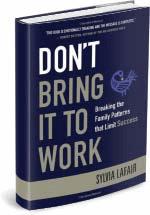How To Diagnose And Treat Team Conflict
By Sylvia Lafair, Ph.D., author of Don’t Bring It to Work
 When many highly educated people work together in a culture heavily focused on logic and science, the relationship realm, with its underbelly of subtle emotions, is often brushed aside. This can lead to systemic difficulties that derail productivity and limit success.
When many highly educated people work together in a culture heavily focused on logic and science, the relationship realm, with its underbelly of subtle emotions, is often brushed aside. This can lead to systemic difficulties that derail productivity and limit success.
When tempers flare and issues are handled quickly, that’s excellent. You have resolved a problem. However, if the same concerns show up over and over, including disappointments, disapproval, and discounting, you are staring at a pattern. Situations that constantly repeat need a different type of understanding to be resolved.
TYPES OF BEHAVIOR PATTERNS THAT CREATE HAVOC
- THE PERSECUTOR: embarrasses associates with finger-pointing and blaming. No resolutions occur because everyone is afraid to take them on. This leads to gossip, rumors, and disconnection.
- THE AVOIDER: leaves the scene, either physically or emotionally, when the going gets rough. Meetings are short-circuited, projects are delayed, and excuses are superficial.
- THE DENIER: pretends everything is perfect, with a desire to maintain the status quo. Facts and statistics are distorted to keep from changing course.
- THE SPLITTER: talks out of both sides of the mouth telling individuals what they want to hear rather than being consistent, thus causing misunderstandings that fuel the fire.
- THE DRAMA QUEEN/KING: takes center stage with over-the-top concerns that lead nowhere and waste time rather than lead to a helpful solution.
ETIOLOGY OF RELATIONAL PATTERNS AND WAY OUT
In his book, Blink, Malcolm Gladwell reports on studies that indicate our overwhelming predisposition for “instant knowing.” People make snap decisions about whether they like each other without realizing it. When bosses or colleagues don’t match our expectations, we realize this in a matter of seconds, and just like that the seeds of conflict are sown. The “blinks” of remembrance come from early in life, from our original organization, the family. We have created work to resemble the family structure. There are bosses, like parents, and colleagues, like siblings. Just as there is a protocol to take a family history for physical illness, the same is needed for conflict resolution.
 Handling underlying conflict is always a two-step process: Understand what triggers your own behavior and then help direct reports explore their reaction patterns.
Handling underlying conflict is always a two-step process: Understand what triggers your own behavior and then help direct reports explore their reaction patterns.
Power is diminished by observing the ingrained, outdated patterns of reacting that create conflict. Next, understand this is more than just a reaction to the present situation, and the intensity is diffused. Then it is possible to transform the pattern to one that is positive; seeds of honesty and trust are planted.
There is room for discussion and change once you and your direct reports can see through those automatic, knee-jerk tendencies to respond. It is only when you stay in the rut of ingrained, outdated responses that no new movement is possible nor real dialogue can happen.
